Pioneers stacked their soap with small gaps between bars to promote essential air circulation during the vital three-week curing process. This stacking method allowed moisture to escape, preventing mold growth while ensuring the soap hardened properly for longer-lasting bars. The technique facilitated complete saponification, mellowed strong lard odors, and enhanced lathering qualities. By creating space between each bar, you'll find pioneers weren't just drying soap—they were transforming it into a superior product through traditional wisdom.
The Science Behind Soap Curing in Pioneer Times
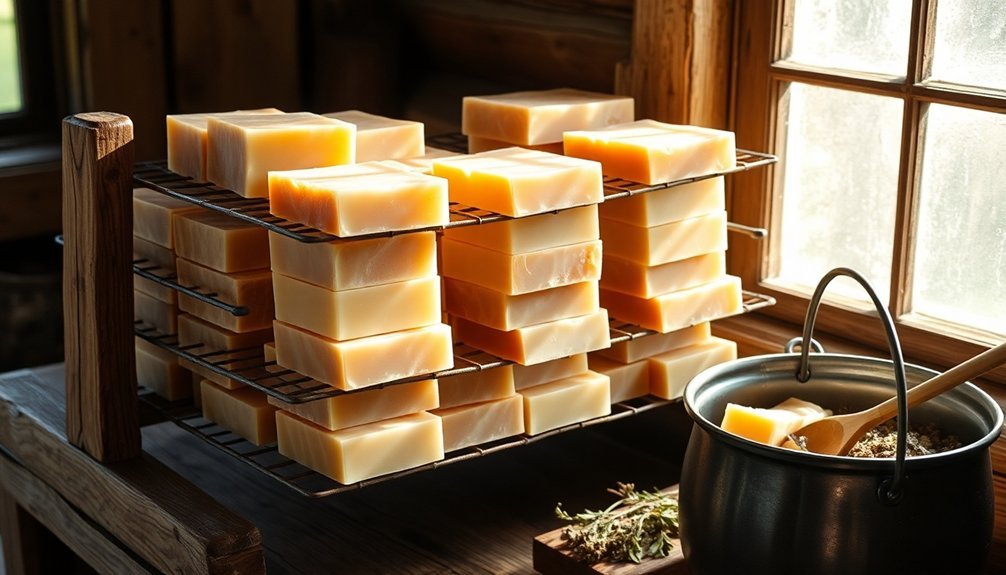
When pioneers crafted soap from scratch, they quickly learned that proper drying was vital to its usability. They weren't just waiting for moisture to evaporate; they were facilitating a complex chemical transformation called saponification.
During the three-week curing process, each bar of soap underwent significant changes. The stacked arrangement allowed air to circulate freely around all surfaces, helping excess moisture escape while the fats and lye reacted properly. You'd notice a firmer, more effective product after proper curing.
This methodical approach served practical purposes beyond basic drying. Any free lye could safely exit the soap, preventing harsh bars that might damage skin.
The curing also mellowed the strong lard odor, resulting in a more pleasant-smelling final product. For soaps with a reddish tint, careful stacking guaranteed even curing of the red lye water.
Traditional Stacking Methods for Homemade Soap
After completing the initial soap-making process, pioneers developed ingenious stacking techniques that maximized both space and airflow.
They'd carefully position each soap bar with just the right amount of space between them—not too close to stick together, but with only a little bit of separation to use space efficiently.
Wooden racks or screens formed the foundation of their stacking systems, providing stability while promoting even air circulation.
You'd find these soap arrangements in any available space where conditions were favorable for drying.
Getting the stacking just right was essential for proper curing, as it allowed moisture to escape from all sides of each bar.
This methodical approach guaranteed the soap dried uniformly over several weeks, transforming harsh, lye-heavy mixtures into gentle, usable cleaning products.
Benefits of Air Circulation in the Soap Drying Process
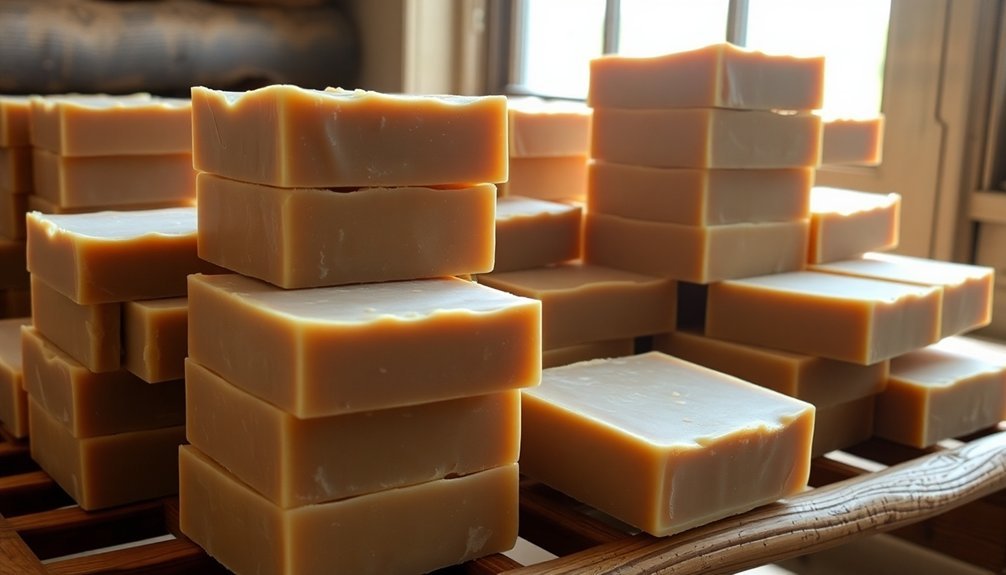
Your properly stacked soap will resist mold growth as air flows freely around each bar, removing excess moisture that would otherwise foster bacterial growth.
You'll notice a notably shorter curing time when bars are properly elevated and separated, often reducing the traditional three-week process by several days.
The quality of your final soap improves dramatically with proper air circulation, resulting in harder bars with better lather and a cleaner scent than soap dried in confined spaces.
Preventing Mold Formation
While the basic soap-making process remained consistent across pioneer settlements, the drying techniques made all the difference between pristine, usable soap and moldy, wasted batches.
Pioneers understood that trapped moisture was soap's worst enemy, creating perfect conditions for mold to flourish.
You'll find their stacking methods were quite strategic to combat this problem:
- Bars were positioned with small gaps between them, allowing air to flow freely on all sides.
- Stacked arrangements were kept in well-ventilated areas, often near windows but away from direct sunlight.
- Periodic rotation of soap bars guaranteed even drying throughout the curing process.
- Elevated racks or platforms were used to increase airflow from underneath the soap.
This meticulous approach to drying prevented wasted resources and guaranteed clean, usable soap.
Accelerating Curing Time
Beyond mold prevention, pioneers recognized that proper stacking techniques greatly accelerated the soap curing process. By allowing air to circulate around each bar, they created the ideal environment for excess moisture and free lye to evaporate efficiently.
When you stack soap with adequate spacing between bars, you're creating multiple exposed surfaces that can dry simultaneously. This strategic arrangement allowed pioneers to cure larger batches at once, maximizing their production space.
The consistent airflow guaranteed uniform drying throughout each bar, eliminating soggy centers that might otherwise take weeks longer to cure properly.
The standard three-week curing period yielded harder, longer-lasting soap that performed better for cleaning tasks. You'll find that this careful attention to air circulation didn't just speed up production—it considerably enhanced the soap's quality and fragrance in the finished product.
Enhancing Soap Quality
Proper air circulation during the drying process transformed ordinary soap into premium cleaning agents that pioneers could rely on.
When you stack soap correctly, you're allowing air to reach all surfaces, which prevents mushiness and encourages excess moisture to evaporate efficiently.
The benefits of proper air circulation include:
- Allowing free lye to exit the soap, resulting in a more balanced and effective product
- Creating a consistent curing process that achieves ideal hardness and longevity
- Minimizing mold and bacterial growth that thrives in stagnant air
- Improving cleansing properties while extending storage life
This method wasn't just about drying—it was about transformation.
The pioneers' stacking technique guaranteed their soap would be durable enough for the harsh conditions of frontier life while maintaining its cleaning effectiveness.
Pioneer Soap Racks: Design and Functionality
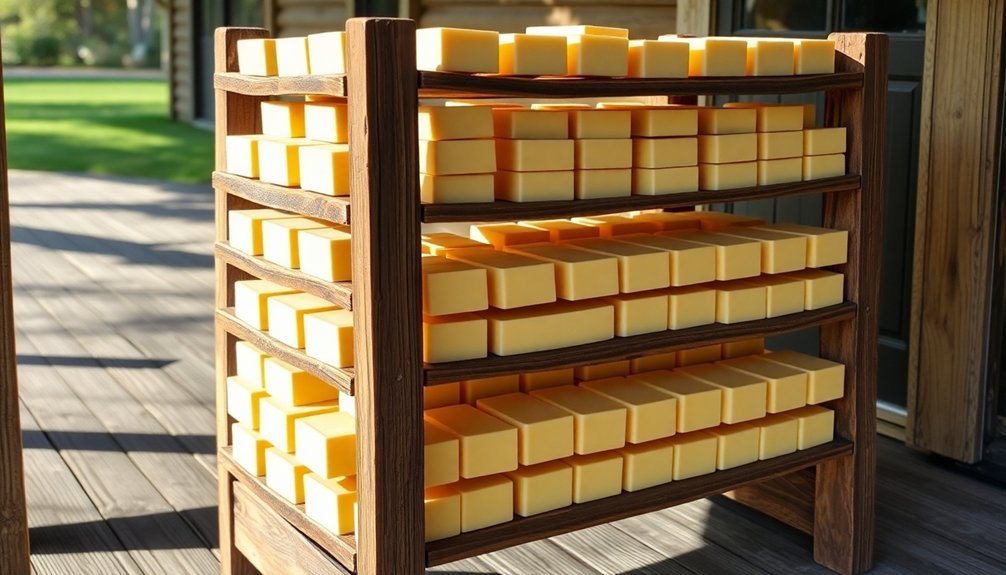
Pioneer soap racks featured a carefully designed airflow optimization system, with slatted wooden platforms that elevated bars to guarantee complete air circulation.
You'd notice how these racks facilitated soap curing mechanics, allowing for even drying and preventing bars from sticking together during the weeks-long hardening process.
The efficient moisture removal capabilities of these racks weren't just convenient—they were essential for producing safe, usable soap by allowing excess lye to evaporate completely.
Airflow Optimization System
While modern drying methods rely on technology, the ingenious soap racks developed by pioneers represented a sophisticated airflow optimization system that secured proper curing.
You'll find that pioneers carefully designed these racks with slatted or spaced configurations that maximized air circulation around each bar.
By stacking soap strategically, pioneers guaranteed:
- Even airflow around all sides of each bar
- Protection from damp surfaces that could cause molding
- Efficient use of limited space during soap-making season
- Elimination of lingering lye smells through continuous ventilation
This systematic approach to drying wasn't just practical—it was essential for creating harder, longer-lasting soap.
The elevated, stacked arrangement allowed moisture to evaporate uniformly, preventing the soft spots and inconsistencies that would occur with inadequate air exposure.
Soap Curing Mechanics
Despite appearing simple, the pioneer soap rack represented a remarkable feat of functional engineering that transformed soap-making efficiency. You'd find these racks designed with slatted shelves or screens that prevented soap from touching surfaces that might trap moisture.
The curing process required about three weeks, during which proper stacking guaranteed the soap hardened properly and became milder for use.
| Rack Feature | Purpose | Benefit |
|---|---|---|
| Slatted design | Maximize airflow | Faster drying time |
| Elevated positioning | Prevent moisture trapping | Reduced mold risk |
| Stackable configuration | Space efficiency | Larger batch capacity |
When properly cured, your soap would develop a pleasant aroma and consistent texture, indicating the lye had fully reacted with the fats—essential for creating safe, effective cleaning products for your household's many needs.
Efficient Moisture Removal
Once the initial soap molding was complete, your attention would turn to the essential drying phase, where pioneer soap racks showcased ingenious design principles that maximized moisture removal.
These racks featured slats or screens that allowed air to circulate around each bar, preventing the moisture buildup that could lead to mold or improper curing.
You'd place your freshly cut soap bars on these specialized racks for several important reasons:
- To promote even drying on all sides of each soap bar
- To keep the soap elevated off damp surfaces that could compromise quality
- To accelerate the curing process through consistent airflow
- To improve the final soap's effectiveness for cleaning and personal hygiene
This stacking approach guaranteed your weeks-long curing process would yield durable, high-quality soap.
The Role of Humidity and Temperature in Soap Curing
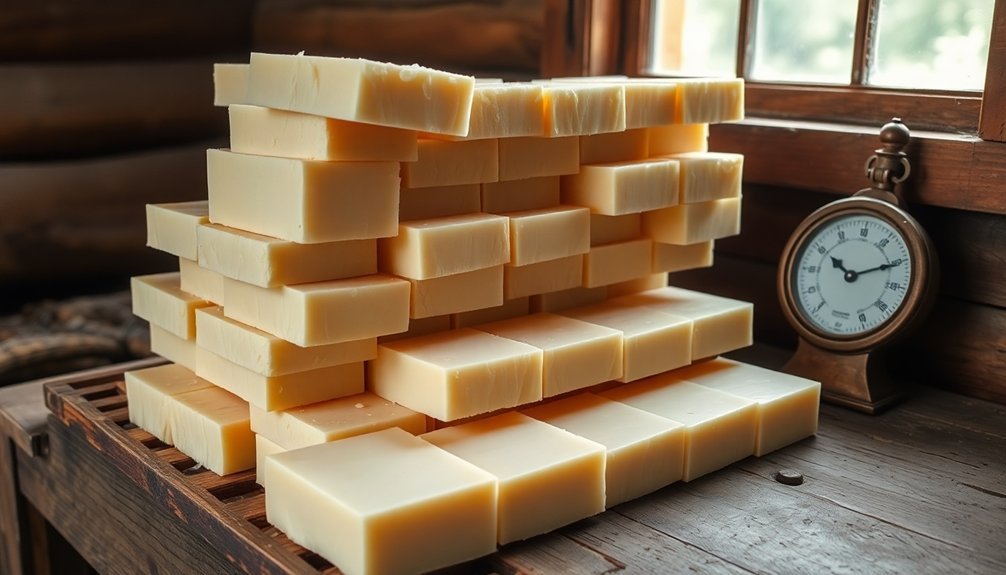
When pioneers crafted their homemade soap, they quickly learned that environmental conditions played an essential role in the final product's quality.
You'd find that humidity was particularly challenging—high moisture levels in the air would slow the evaporation process, resulting in softer, less effective soap.
By stacking their soap bars, pioneers created space between each piece, promoting air circulation that combated humidity's effects.
Temperature was equally important; warmer environments accelerated the curing process, helping the soap harden properly.
This stacking method also maximized limited drying space, allowing pioneers to cure more soap simultaneously without sacrificing quality.
The careful balance of humidity control and temperature management guaranteed their soap would properly harden and be safe for use—a necessity for frontier living.
How Soap Stacking Improved Quality and Longevity
The strategic method of soap stacking that pioneers developed went far beyond simple space efficiency. This technique markedly enhanced the final product's quality by promoting even airflow around each bar, allowing moisture to evaporate consistently.
When you properly stack soap, you'll achieve:
- Firmer texture and longer-lasting bars that require less frequent replacement
- Prevention of bars sticking together, preserving their individual shapes
- Minimized surface imperfections across all bars
- Consistent quality throughout your batch
This approach was particularly valuable in pioneer settings with limited space or during humid conditions. By maximizing drying area while ensuring proper curing, pioneer women created superior soap that maintained its effectiveness for cleaning clothes, bodies, and household items—a critical resource when every homemade product needed to last.
Regional Variations in Pioneer Soap Drying Techniques
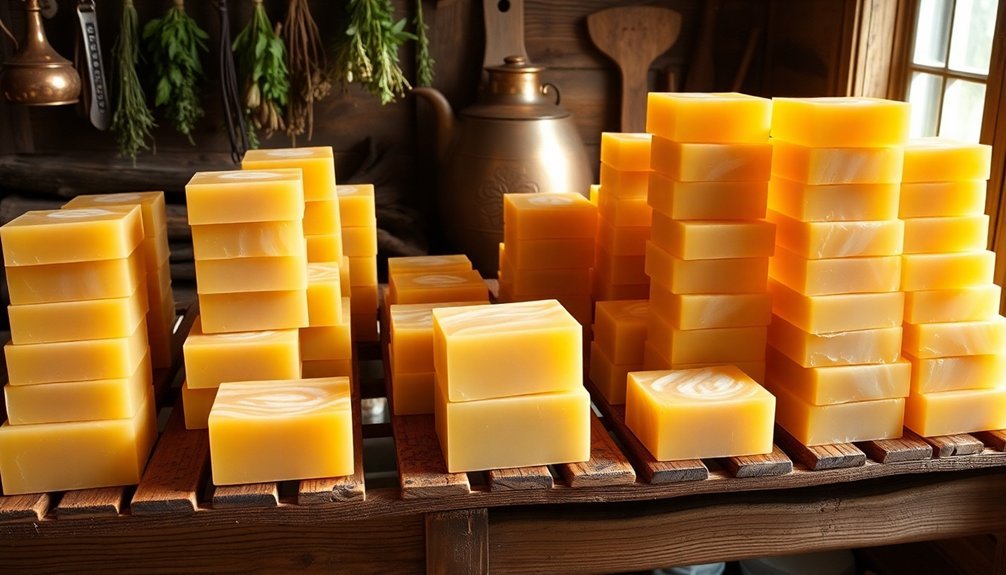
Although basic soap-making principles remained consistent across the American frontier, pioneers adapted their drying techniques to address diverse regional challenges.
In humid areas, you'd find soap stacked in well-ventilated spaces that maximized air circulation, while those in colder climates positioned their soap near fireplaces to combat winter's chill.
Available materials dictated stacking methods too. Wooden racks and pallets became popular for elevating soap above damp ground, preventing moisture damage.
Many pioneers separated soap layers with parchment or cloth, ensuring even drying and preventing sticking—especially important in fluctuating humidity.
Sun-rich regions developed distinctive approaches, with settlers taking advantage of natural light by arranging soap outdoors on specially designed racks.
This resourcefulness reflected pioneers' remarkable ability to adapt soap production to their environment's unique conditions.
Tools and Materials Used for Soap Stacking Arrangements
When making soap, you'll need wooden racks or screens as essential tools for proper stacking arrangements that maximize airflow.
These sturdy platforms allowed pioneers to position soap blocks with enough space between them, preventing contact that could cause stickiness or deformation during the three-week curing process.
Your stacking method directly impacts how efficiently excess lye escapes and how uniformly your soap cures, making thoughtful arrangement a critical step in traditional soap production.
Stacking Soap Tools
Resourceful pioneers developed specialized tools for soap stacking arrangements that assured proper curing and quality results.
You'll find that these homesteaders prioritized airflow and efficient space usage when designing their soap-drying systems.
Wooden crates and slatted drying racks became the standard tools, allowing you to properly space each bar without risk of sticking or deformation.
When you're producing soap in large quantities, proper arrangement makes all the difference.
- Slatted surfaces and screens were positioned at the bottom to promote drainage
- Wooden crates with gaps provided essential air circulation
- Stacked arrangements maximized limited storage space
- Strategic placement in well-ventilated areas accelerated the curing process
These thoughtful stacking methods guaranteed your soap dried evenly, preventing waste and assuring high-quality products for household use.
Air Circulation Methods
Pioneers understood that proper air circulation meant the difference between usable soap and wasted ingredients. They developed effective stacking systems using readily available materials to guarantee every bar cured properly.
| Material | Purpose |
|---|---|
| Wooden racks | Created separation between soap layers |
| Screens | Prevented condensation on bottom layers |
| Slotted shelves | Maximized airflow around each bar |
| Mesh materials | Allowed moisture to escape from all sides |
| Barn rafters | Utilized natural air currents in elevated spaces |
You'd find most pioneer soap curing in well-ventilated outbuildings where consistent airflow could reach all sides of the stacked bars. This methodical approach guaranteed moisture evaporated evenly, resulting in harder, longer-lasting soap. Without these circulation techniques, bars would remain soft and potentially spoil, wasting precious resources and hours of labor.
Seasonal Adjustments to the Soap Curing Process
Although soap making remained consistent year-round, the drying process demanded careful seasonal adjustments to guarantee quality and usability. Pioneers understood that environmental conditions greatly impacted how their soap would cure and perform.
During wetter months, proper stacking became even more critical to prevent soap from absorbing excess moisture from the air. In cold climates, you'd position your drying racks near heat sources like fireplaces to accelerate the process.
- Moisture control was paramount – stacked soap dried more efficiently as air circulated between layers.
- Winter required proximity to heat sources to maintain the three-week curing timeline.
- Summer humidity demanded extra spacing between soap bars.
- Wooden slats or screens between layers prevented sticking and promoted additional airflow.
From Liquid to Solid: The Transformation During Stacking
The transformation from liquid soap to solid usable bars represented a fascinating alchemical process that depended heavily on proper stacking techniques.
When you stacked your freshly made soap, you weren't simply organizing it—you were facilitating an essential chemical reaction.
As your soap blocks sat separated in their stacked formation, air circulated around each piece, allowing excess moisture and lye to sweat out evenly.
You'd notice your soap gradually hardening over the three-week curing period, transforming from soft, caustic mixture to firm, usable product.
This careful stacking prevented mold growth that could ruin your precious soap supply.
Without this methodical approach to drying, your soap wouldn't achieve the proper texture needed for effective cleaning of both clothes and bodies.
Historical Evidence of Soap Stacking Practices
Historical diaries and writings from the 19th century provide us with tangible evidence of soap stacking methods that evolved across different pioneer communities.
These records show how pioneers developed systematic approaches to soap curing, with stacking emerging as the preferred technique across various settlements.
Documentary evidence points to four primary stacking patterns:
- Criss-cross arrangement – alternating bar directions for maximum air circulation
- Pyramid style – wider base tapering to single bars at top
- Log cabin method – rectangular arrangement with central air channel
- Grid pattern – uniform spacing between bars on slatted wooden racks
Archaeological findings from pioneer homesteads have uncovered dedicated drying areas where soap stacks were positioned away from direct sunlight but with ample airflow.
These discoveries confirm how critical proper stacking was to the pioneers' soap-making success and household economy.
Modern Adaptations of Pioneer Soap Curing Methods
Despite maintaining respect for traditional techniques, contemporary soap makers have revolutionized pioneer curing methods with innovations designed for efficiency and consistency.
You'll find wire racks and screens replacing the simple stacking methods, allowing air to circulate fully around each bar for faster, more uniform drying.
Silicone molds have supplanted wooden boxes and repurposed dishes, ensuring easy removal and consistent shapes.
Today's crafters enhance their soaps with essential oils and natural colorants during mixing—options pioneers rarely had available.
Modern soap makers can also adjust curing times based on specific oil combinations, sometimes achieving usable soap in less time than their ancestors required.
Through workshops and online tutorials, you'll learn to blend these historical techniques with modern safety practices, preserving tradition while embracing innovation.
Frequently Asked Questions
What Did Pioneers Use for Laundry Soap?
You'd use homemade soap for laundry as a pioneer. You'd make it by boiling lye with animal fat or vegetable oil, creating an effective cleaning agent you'd cure for three weeks.
Why Did People in the Early 1800S Not Use Soap Often?
You didn't use soap often in the 1800s because it was expensive and time-consuming to make. Limited ingredients, economic constraints, and different hygiene standards meant you'd save it for essential cleaning tasks only.
How Did Pioneers Dry Their Clothes?
You'd hang your clothes outdoors to harness sun and wind for drying. When weather didn't cooperate, you'd dry them indoors near the fireplace's warmth. Your limited wardrobe made laundry day an essential weekly routine.
What Did Pioneers Use for Soap?
You'd make soap using animal fat (tallow), lye from wood ashes, and water. This homemade combination served all your cleaning needs. Some pioneers also added pine tar or coconut oil for specialized purposes.
In Summary
You've now seen why pioneers stacked their soap—it wasn't just tradition but practical science. By creating air circulation between bars, they accelerated drying, reduced moisture, and prevented waste. You'll find these time-tested methods still work today if you're making homemade soap. The pioneers' careful attention to curing conditions guaranteed longer-lasting, better-performing soap, a wisdom that's carried through to modern soap-making practices.





Leave a Reply